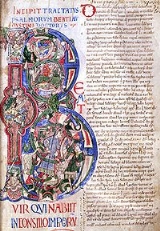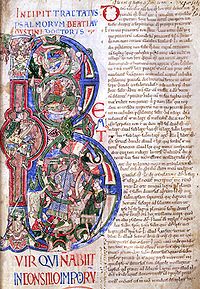
Saint-Evroul-sur-Ouche
Encyclopedia
The Abbey of Saint-Evroul or Saint-Evroul-sur-Ouche (Saint-Evroult-sur-Ouche, Saint-Evroul-en-Ouche, Saint-Evroult-en-Ouche, Abbaye de Saint-Evroult, Sanctus Ebrulphus Uticensis ) is a former Benedictine abbey
in Normandy
, located in the present commune of Saint-Evroult-Notre-Dame-du-Bois
, Orne
, Basse-Normandie
. Its name refers to its founder, Ebrulf
(Evroul), who founded a hermitage
in the forest of Ouche
around 560. The abbey was rebuilt around 1000.
Robert de Grantmesnil served as abbot of Saint-Evroul, which he helped restore in 1050. He had become a monk at Saint-Evroul before becoming its abbot.
Orderic Vitalis
entered the abbey as a young boy and later wrote a history of the abbey.
 Normandy was the site of several important developments in the history of classical music
Normandy was the site of several important developments in the history of classical music
in the eleventh century. Fécamp Abbey
and Saint-Evroul were centres of musical production and education. At Saint-Evroul, a tradition of singing had developed and the choir achieved fame in Normandy. After entering into a violent quarrel with William II of Normandy, Robert de Grantmesnil had been forced to flee to Rome
in January 1061 and thence to the court of Robert Guiscard
in Salerno
, taking with him eleven of his monks, including his nephew Berengar
. In his time, Saint-Evroul was famed for its musical programme and these eleven monks brought its musical traditions to the abbey of Sant'Eufemia (now part ot town of Lamezia Terme and different from Sant'Eufemia d'Aspromonte) in Calabria
, a foundation of the Guiscards, of which Robert became abbot.
Abbey
An abbey is a Catholic monastery or convent, under the authority of an Abbot or an Abbess, who serves as the spiritual father or mother of the community.The term can also refer to an establishment which has long ceased to function as an abbey,...
in Normandy
Normandy
Normandy is a geographical region corresponding to the former Duchy of Normandy. It is in France.The continental territory covers 30,627 km² and forms the preponderant part of Normandy and roughly 5% of the territory of France. It is divided for administrative purposes into two régions:...
, located in the present commune of Saint-Evroult-Notre-Dame-du-Bois
Saint-Evroult-Notre-Dame-du-Bois
Saint-Evroult-Notre-Dame-du-Bois is a commune in the Orne department in north-western France.-See also:*Communes of the Orne department* -References:*...
, Orne
Orne
Orne is a department in the northwest of France, named after the river Orne.- History :Orne is one of the original 83 departments created during the French Revolution, on March 4, 1790. It was created from parts of the former provinces of Normandy and Perche.- Geography :Orne is in the region of...
, Basse-Normandie
Basse-Normandie
Lower Normandy is an administrative region of France. It was created in 1956, when the Normandy region was divided into Lower Normandy and Upper Normandy...
. Its name refers to its founder, Ebrulf
Ebrulf
Ebrulf was a Frankish saint, hermit, and abbot. He was born at either Bayeux or Beauvais. A Merovingian courtier at the court of Childebert I, he was a cup-bearer to the king and an administrator of the royal palace.It was some time before he was given leave to go from court, but Ebrulf wished...
(Evroul), who founded a hermitage
Hermitage (religious retreat)
Although today's meaning is usually a place where a hermit lives in seclusion from the world, hermitage was more commonly used to mean a settlement where a person or a group of people lived religiously, in seclusion.-Western Christian Tradition:...
in the forest of Ouche
Pays d'Ouche
The Pays d'Ouche is an historical and geographical region in Normandy. It extends from the southwest of Évreux up to Bernay and Beaumont-le-Roger as a northern limit, and down to L'Aigle and to Gacé in the south....
around 560. The abbey was rebuilt around 1000.
Robert de Grantmesnil served as abbot of Saint-Evroul, which he helped restore in 1050. He had become a monk at Saint-Evroul before becoming its abbot.
Orderic Vitalis
Orderic Vitalis
Orderic Vitalis was an English chronicler of Norman ancestry who wrote one of the great contemporary chronicles of 11th and 12th century Normandy and Anglo-Norman England. The modern biographer of Henry I of England, C...
entered the abbey as a young boy and later wrote a history of the abbey.
Musical tradition

Classical music
Classical music is the art music produced in, or rooted in, the traditions of Western liturgical and secular music, encompassing a broad period from roughly the 11th century to present times...
in the eleventh century. Fécamp Abbey
Fécamp Abbey
Fécamp Abbey is a Benedictine abbey in Normandy, northern France.The abbey was the first producer of Bénédictine, a herbal liqueur, based on brandy.-First foundation:...
and Saint-Evroul were centres of musical production and education. At Saint-Evroul, a tradition of singing had developed and the choir achieved fame in Normandy. After entering into a violent quarrel with William II of Normandy, Robert de Grantmesnil had been forced to flee to Rome
Rome
Rome is the capital of Italy and the country's largest and most populated city and comune, with over 2.7 million residents in . The city is located in the central-western portion of the Italian Peninsula, on the Tiber River within the Lazio region of Italy.Rome's history spans two and a half...
in January 1061 and thence to the court of Robert Guiscard
Robert Guiscard
Robert d'Hauteville, known as Guiscard, Duke of Apulia and Calabria, from Latin Viscardus and Old French Viscart, often rendered the Resourceful, the Cunning, the Wily, the Fox, or the Weasel was a Norman adventurer conspicuous in the conquest of southern Italy and Sicily...
in Salerno
Salerno
Salerno is a city and comune in Campania and is the capital of the province of the same name. It is located on the Gulf of Salerno on the Tyrrhenian Sea....
, taking with him eleven of his monks, including his nephew Berengar
Berengar, Bishop of Venosa
Berengar was the Bishop of Venosa. He is mentioned for the last time at Christmas 1096.The son of Arnaud d'Échauffour, he became a monk in Saint-Evroul-sur-Ouche as a youth. He was a student of Abbot Thierri....
. In his time, Saint-Evroul was famed for its musical programme and these eleven monks brought its musical traditions to the abbey of Sant'Eufemia (now part ot town of Lamezia Terme and different from Sant'Eufemia d'Aspromonte) in Calabria
Calabria
Calabria , in antiquity known as Bruttium, is a region in southern Italy, south of Naples, located at the "toe" of the Italian Peninsula. The capital city of Calabria is Catanzaro....
, a foundation of the Guiscards, of which Robert became abbot.
Secondary sources
- Joranson, Einar. "The Inception of the Career of the Normans in Italy — Legend and History." SpeculumSpeculum (journal)Speculum: A Journal of Medieval Studies is a quarterly academic journal published by the Medieval Academy of America. It was established in 1926. The journal's primary focus is on the time period from 500-1500 in Western Europe, but also on related subjects such as Byzantine, Hebrew, Arabic, and...
, Vol. 23, No. 3. (Jul., 1948), pp 353–396.

